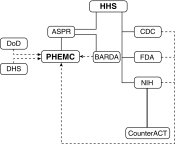An Official American Thoracic Society Workshop Report: Chemical Inhalational Disasters. Biology of Lung Injury, Development of Novel Therapeutics, and Medical Preparedness
- PMID: 28418689
- PMCID: PMC5529138
- DOI: 10.1513/AnnalsATS.201704-297WS
An Official American Thoracic Society Workshop Report: Chemical Inhalational Disasters. Biology of Lung Injury, Development of Novel Therapeutics, and Medical Preparedness
Abstract
This report is based on the proceedings from the Inhalational Lung Injury Workshop jointly sponsored by the American Thoracic Society (ATS) and the National Institutes of Health (NIH) Countermeasures Against Chemical Threats (CounterACT) program on May 21, 2013, in Philadelphia, Pennsylvania. The CounterACT program facilitates research leading to the development of new and improved medical countermeasures for chemical threat agents. The workshop was initiated by the Terrorism and Inhalational Disasters Section of the Environmental, Occupational, and Population Health Assembly of the ATS. Participants included both domestic and international experts in the field, as well as representatives from U.S. governmental funding agencies. The meeting objectives were to (1) provide a forum to review the evidence supporting current standard medical therapies, (2) present updates on our understanding of the epidemiology and underlying pathophysiology of inhalational lung injuries, (3) discuss innovative investigative approaches to further delineating mechanisms of lung injury and identifying new specific therapeutic targets, (4) present promising novel medical countermeasures, (5) facilitate collaborative research efforts, and (6) identify challenges and future directions in the ongoing development, manufacture, and distribution of effective and specific medical countermeasures. Specific inhalational toxins discussed included irritants/pulmonary toxicants (chlorine gas, bromine, and phosgene), vesicants (sulfur mustard), chemical asphyxiants (cyanide), particulates (World Trade Center dust), and respirable nerve agents.
Figures

References
-
- U.S. Department of Homeland Security. Report on the Toxic Chemical Syndrome: Definitions and Nomenclature Workshop. May 2012 [accessed 2017 Feb 13]. Available from: https://chemm.nlm.nih.gov/Report_from_Toxic_Syndrome_Workshop_final.pdf.
-
- Nelson LS, Hoffman RS. Inhaled toxins. In: Marx JA, Hockberger RS, Walls RM, editors. Rosen’s emergency medicine: concepts and clinical practice. 8th ed. Philadelphia: Elsevier/Saunders; 2014. pp. 2036–2043.
-
- Parkes WR.Aerosols: their deposition and clearance Parkes WR.editor. Occupational lung disorders, 3rd ed Oxford: Butterworth-Heinemann; 199435
-
- Chen LC, Thurston G. World Trade Center cough. Lancet. 2002;360:s37–s38. - PubMed
-
- Muskat PC. Mass casualty chemical exposure and implications for respiratory failure. Respir Care. 2008;53:58–63, discussion 63–66. - PubMed
MeSH terms
Grants and funding
LinkOut - more resources
Full Text Sources
Other Literature Sources
Medical

